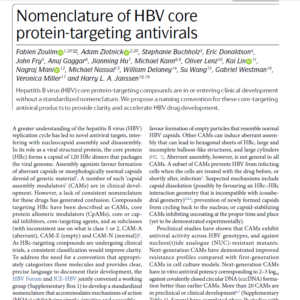
A greater understanding of the hepatitis B virus (HBV)
replication cycle has led to novel antiviral targets, interfering
with nucleocapsid assembly and disassembly.
In its role as a viral structural protein, the core protein
(HBc) forms a capsid of 120 HBc dimers that packages
the viral genome. Assembly agonists favour formation
of aberrant capsids or morphologically normal capsids
devoid of genetic material1. A number of such ‘capsid
assembly modulators’ (CAMs) are in clinical development.
However, a lack of consistent nomenclature
for these drugs has generated confusion. Compounds
targeting HBc have been described as CAMs, core
protein allosteric modulators (CpAMs), core or capsid
inhibitors, core-targeting agents, and as subclasses
(with inconsistent use on what is class 1 or 2, CAM-A
(aberrant), CAM-E (empty) and CAM-N (normal))2.
As HBc-targeting compounds are undergoing clinical
trials, a consistent classification would improve clarity.
To address the need for a convention that appropriately
categorizes these molecules and provides clear,
precise language to document their development, the
HBV Forum and ICE-HBV jointly convened a working
group (Supplementary Box 1) to develop a standardized
nomenclature that accommodates mechanisms of action
(MOAs) whilst being simple, intuitive and accessible.
